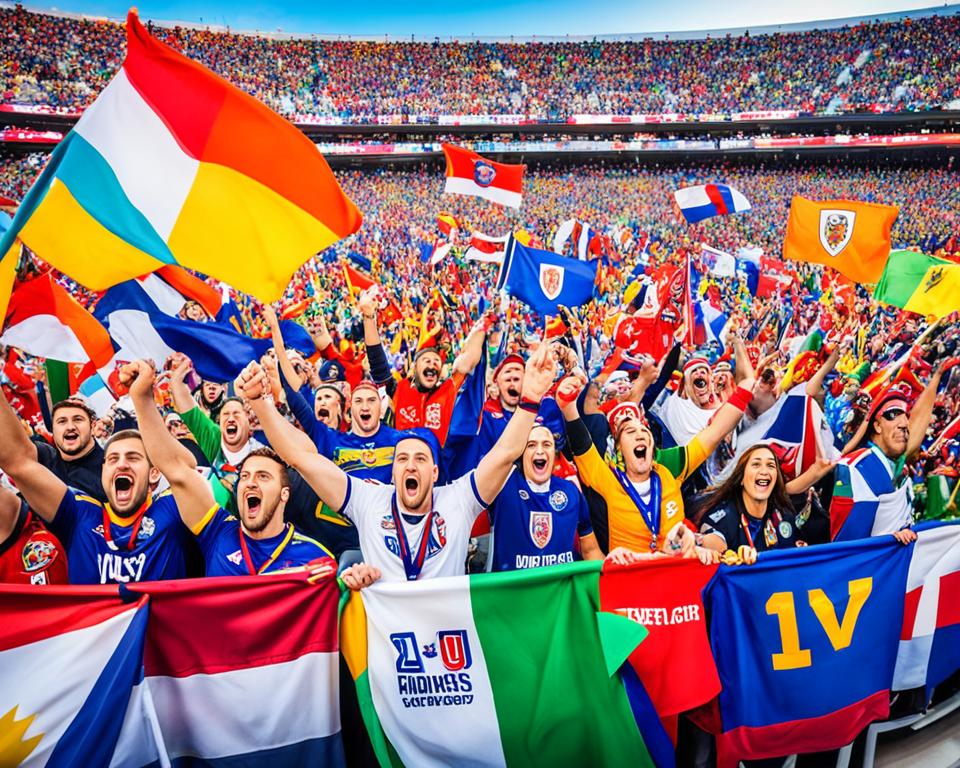Imagine the roars of crowded stadiums, the pulse of anticipation, and the unbridled joy of victory that resonate across nations—this is the allure of the sports craze worldwide. Spanning from the lush pitches hosting the FIFA World Cup to the illustrious Olympic arenas, and the pulsating courts of the NBA, global athletic events demonstrate a unifying language that transcends borders. We’re about to embark on a journey through the realm of international sports fascination, examining the colossal wave of excitement and national pride that only major sports spectacles can ignite.
The vibrant tapestry of global athletic events stitches together communities from disparate corners of the world, sparking an international camaraderie that is both infectious and inspiring. As we explore this multicolored mosaic, the emotional depths and heights of sportsmanship reveal themselves, fostering a profound international fellowship. Let this be your guide to understanding and appreciating the cultural nuances and shared passions that make major sports spectacles a true testament to humanity’s collective spirit.
Exploring the Roots of Global Sports Phenomenon
As we delve into the rich tapestry of global sports, it becomes evident how deeply intertwined they are with the culture and history of societies around the world. From ancient competitions to modern mega-events, sports have always served as a reflection of human endeavor and unity. This section explores how sports evolved from local pastimes to pillars of international fandom and diplomacy.
The Origins of Worldwide Sports Fandom
The concept of international fandom origins dates back to the days when the Olympic Games commenced in Ancient Greece. Such historical sports milestones have nurtured a global community of fans who not only appreciate athleticism but celebrate the cultural exchange that comes with every game. These events marked the beginning of sports as a universal language, spoken across continents and cultures.
The Rise of International Sports Events
As competitions expanded beyond borders, the structure and governance of sports also evolved. The establishment of international bodies like FIFA and the International Olympic Committee marked a significant shift, transforming local tournaments into global spectacles. This progression underscores the importance of sports as a platform for global sports diplomacy, fostering connections and mutual respect among diverse nations.
Cultural Impact of Sports on Global Scale
Sports have the unique ability to break down barriers and serve as a diplomatic tool, easing political tensions and promoting global solidarity. Significant events such as Ping Pong Diplomacy and the role of sports in easing Cold War tensions highlight the pivotal role sports play in international relations. These instances exemplify how sports can transcend athletic competition to become a means of peaceful engagement between countries.
The Role of Media in Spreading Global Sports Phenomenon
Understanding the profound influence of media on sports is crucial in grasping how sports have become a universal phenomenon. From the early days of radio broadcasting to today’s digital streaming, the sports broadcasting evolution has played a pivotal role in making sports accessible globally. Below, we explore various facets through which media has broadened the horizon of sports viewership and fan engagement.
- Increasing Accessibility: As television networks went global and internet streaming came into being, the doors to international sports events opened wider for millions around the world, tremendously increasing global sports viewership. This democratization of access means that events such as the Olympics and the FIFA World Cup are watched and celebrated worldwide.
- Innovations in Sports Journalism: The sports journalism impact has been significant with advancements such as replays, multiple camera angles, and VR experiences which have drastically enhanced the viewer’s experience. These technological innovations not only enrich the way fans consume sports but also allow deeper narratives and stories to emerge, captivating a broader audience.
- Role of Social Media: Social media and sports have intertwined in ways that have redefined fan engagement. Platforms like Twitter, Instagram, and Facebook allow fans to engage in real-time during live events, creating vibrant communities of supporters across the globe. Social media channels also offer athletes a platform to build their personal brand and directly communicate with their fan base, adding personal layers to their professional achievements.
As we continue to witness the intersection of media technology and sports, it is clear that the media’s role is integral in sculpting the sports landscape, driving not just viewership but also creating a interconnected global sports culture. //
Global Sports Phenomenon: Bridging Cultures and Communities
The unifying power of sports is universally recognized as a catalyst for cross-cultural understanding and camaraderie. Across nations, sportsmanship and global connection flourish where language barriers and political differences fade into the background, replaced by the shared passion of players and fans alike. This remarkable phenomenon is evident in international sports communities where individuals convene, united by the heart-pounding excitement of competition and the celebration of human potential.
Historical incidents, like the 1995 Rugby World Cup in South Africa, showcase the remarkable capacity for cross-cultural sporting events to heal and unite. Nelson Mandela’s embrace of the sport, once a symbol of division, transformed the rugby field into a stage for reconciliation. Fast forward to the present, events such as the Olympics and the FIFA World Cup continue to forge connections, drawing billions of spectators into a shared narrative of triumph and heartbreak, reflecting an extraordinary global bond. These gatherings are not just a display of athletic prowess but a powerful force in creating enduring relationships between diverse nations.
The benefits of hosting global sports events extend well beyond the field. Cities that host such events enjoy substantial economic uplifts from tourism and infrastructure development. Equally valuable is the impact on social cohesion, as these events provide a sense of pride and collective identity among members of the community. Initiatives like the United Nations Office on Sport for Development and Peace (UNOSDP) leverage the appeal of sports to promote youth development and cultural exchanges. Grassroots programs across the world utilize sports as a conduit for inclusivity and community building, tangible proof of the impact of sports on weaving the social fabric tighter.
